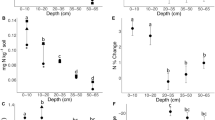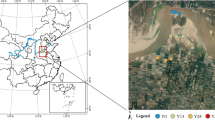Abstract
We assessed recent changes in the distribution of soil total phosphorus (TP) in Water Conservation Area 3 (WCA-3) of the Everglades. Soil cores were collected in 1992 and 2003 at 176 sites. To reflect hydrologic boundaries within the system, WCA-3 was divided into three zones (3AN, 3AS, and 3B). Total P was mapped on both a mass (TPm) and a volumetric basis (TPv) to determine if spatial distributions varied depending on the choice of units. Interpolated maps for both years showed that the highest levels of TPm were located in 3AN and in boundary areas of all zones that received surface water inputs of P from canals. Increases in TPm were greatest in central 3AN in an area adjacent to the Miami Canal that received inputs from a water control structure. Interpolated maps for TPv illustrated that a hotspot present in 1992 had disappeared by 2003. The highest levels of TPv in 2003 were located in northwestern 3AN, a region of WCA-3 that has been chronically overdrained and burned in 1999. From 1992 to 2003, increases in TPm were observed for 53% of the area of WCA-3, while only 16% of WCA-3 exhibited increases in TPv. In 1992, approximately 21% of WCA-3 had TPm concentrations in the 0–10 cm layer >500 mg kg−1, indicating P enrichment beyond historic levels. Eleven years later, 30% of the area of WCA-3 had TPm >500 mg kg−1. This indicated that during this period, the area of WCA-3 with enriched TPm concentrations increased about one % year−1.
Similar content being viewed by others
References
Anderson, J. M. (1976). An ignition method for determination of total phosphorus in lake sediments. Water Research, 10, 329–331.
Arfstrom, C., MacFarlane, A., & Jones, R. D. (2000). Distribution of mercury and phosphorus in everglades soils from water conservation area 3A, Florida, U.S.A. Water, Air, and Soil Pollution, 121, 133–159.
Brown, R. B., Stone, E. L., & Carlisle, V. W. (1991). Soils. In R. L. Myers & J. J. Ewl (Eds.), Ecosystems of Florida. Orlando, FL: University of Central Florida Press.
Bruland, G. L., Grunwald, S., Osborne, T. Z., Reddy, K. R., & Newman, S. (2006). Spatial Distribution of Soil Properties in Water Conservation Area 3 of the Everglades. Soil Science Society of American Journal, 70, 1662-1676.
Bruland, G. L., & Richardson, C. J. (2004). A spatially explicit investigation of P sorption and related soil properties in two riparian wetlands. Journal of Environmental Quality, 33, 785–794.
Childers, D. L., Doren, R. F., Jones, R., Noe, G. B., Rugge, M., & Scinto, L. J. (2003). Decadal changes in vegetation and soil phosphorus pattern across the Everglades landscape. Journal of Environmental Quality, 32, 344–362.
Craft, C. B., & Richardson, C. J. (1993a). Peat accretion and phosphorus accumulation along a eutrophication gradient in the northern Everglades. Biogeochemistry, 22, 133–156.
Craft, C. B., & Richardson, C. J. (1993b). Peat accretion and N, P, and organic C accumulation in nutrient-enriched and unenriched Everglades peatlands. Ecological Applications, 3, 446–458.
Craft, C. B., & Richardson, C. J. (1997). Relationships between soil nutrients and plant species composition in Everglades peatlands. Journal of Environmental Quality, 26, 224–232.
David, P. G. (1996). Changes in plant communities relative to hydrologic conditions in the Florida Everglades. Wetlands, 16, 15–23.
Davis, S. M. (1991). Growth, decomposition, and nutrient retention of Cladium jamaicense Crantz and Typha domigensis Pers. in the Florida Everglades. Aquatic Botany, 40, 203–224.
Davis, S. M. (1994). Phosphorus inputs and vegetation sensitivity in the Everglades. In S. M. Davis & J. C. Ogden (Eds.), Everglades: The ecosystem and its restoration. Delray Beach, FL: St. Lucie.
Davis, S. M., & Ogden, J. C. (Eds.) (1994). Everglades: The ecosystem and its restoration. Delray Beach, FL: St. Lucie.
DeBusk, W. F., Newman, S., & Reddy, K. R. (1994). Spatial patterns of soil phosphorus in Everglades Water Conservation Area 2A. Soil Science Society of American Journal, 58, 543–552.
DeBusk, W. F., Newman, S., & Reddy, K. R. (2001). Spatio-temporal patterns of soil phosphorus enrichment in Everglades Water Conservation Area 2A. Journal of Environmental Quality, 30, 1438–1446.
Drake, H. L., Aumen, N. G., Kuhner, C., Wagner, C., Griebhammer, A., & Schmittroth, M. (1996). Anaerobic microflora on Everglades sediments: Effects of nutrients on population profiles and activities. Applied and Environmental Microbiology, 62, 486–493.
Gaiser, E. E., Trexler, J. C., Richards, J. H., Childers, D. L., Lee, D., Edwards, A. L., et al. (2005). Cascading ecological effects of low-level phosphorus enrichment in the Florida Everglades. Journal of Environmental Quality, 34, 717–723.
Gleason, P. J., Cohen, A. D., Stone, P., Smith, W. G., Brooks, H. K., Goodrick, R., et al. (1974). The environmental significance of Holocene sediments from the Everglades and saline tidal plains. In P. J. Gleason (Ed.), Environments of south Florida, present, and past (pp 297–351). Coral Gables, FL: Miami Geol. Soc.
Grimshaw, H. J., Rosen, M., Swift, D. R., Rodberg, K., & Noel, J. M. (1993). Marsh phosphorus concentrations, phosphorus content and species composition of Everglades periphyton communities. Archiv fur Hydrobiologie, 128, 257–276.
Grunwald, S., Reddy, K. R., Newman, S., & DeBusk, W. B. (2004). Spatial variability, distribution, and uncertainty assessment of soil phosphorus in a south Florida wetland. Journal of Envirometrics, 15, 811–825.
King, R. S., Richardson, C. J., Urban, D. L., & Romanowicz, E. A. (2004). Spatial dependency of vegetation–environment linkages in an anthropogenically influenced wetland ecosystem. Ecosystems, 7, 75–97.
Koch, M. S., & Reddy, K. R. (1992). Distribution of soil and plant nutrients along a trophic gradient in the Florida Everglades. Soil Science Society of American Journal, 56, 1492–1499.
McCormick, P. V., Newman, S., Miao, S. L., Gawlik, D. E., Marley, D., Reddy, K. R., et al. (2001). Effects of anthropogenic phosphorus inputs on the Everglades. In J. W. Porter & K. G. Porter (Eds.), The Everglades, Florida Bay, and coral reefs of the Florida keys: An ecosystem sourcebook (pp 83–126). Boca Raton, FL: CRC.
McCormick, P. V., & O’Dell, M. B. (1996). Quantifying periphyton responses to phosphorus in the northern Everglades: A synoptic approach. Journal of the North American Benthological Society, 15, 433–449.
McCormick, P. V., & Stevenson, R. J. (1998). Periphyton as a tool for ecological assessment and management in the Florida Everglades. Journal of Phycology, 34, 726–733.
Newman, S., Grace, J. B., & Koebel, J. W. (1996). The effects of nutrients and hydroperiod on mixtures of Typha domigensis, Cladium jamaisense, and Eleocharis interstincta: Implications for Everglades restoration. Ecological Applications, 6, 774–783.
Newman, S., McCormick, P. V., Miao, S. L., Laing, J. A., Kennedy, W. C., & O’Dell, M. B. (2004). The effect of phosphorus enrichment on the nutrient status of a northern Everglades slough. Wetlands Ecology and Management, 12, 63–79.
Newman, S., Reddy, K. R., DeBusk, W. F., Wang, Y., Shih, G., & Fisher, M. M. (1997). Spatial distribution of soil nutrients in a northern Everglades marsh: Water Conservation Area 1. Soil Science Society of American Journal, 61, 1275–1283.
Newman, S., Schuette, J., Grace, J. B., Rutchey, K., Fontaine, T., Reddy, K. R., et al. (1998). Factors influencing cattail abundance in the northern Everglades. Aquatic Botany, 60, 265–280.
Noe, G. B., Childers, D. L., & Jones, R. D. (2001). Phosphorus biogeochemistry and the impact of phosphorus enrichment: Why is the Everglades so unique? Ecosystems, 4, 603–624.
Reddy, K. R., Wang, Y., DeBusk, W. F., Fisher, M. M., & Newman, S. (1998). Forms of soil phosphorus in selected hydrologic units of the Florida Everglades. Soil Science Society of American Journal, 62, 1134–1147.
Reddy, K. R., Wang, Y., DeBusk, W. F., & Newman, S. (1994). Physico-chemical properties of soils in the Water Conservation Area 3 (WCA-3) of the Everglades. Final Report, South Florida Water Management District, West Palm Beach, FL.
Reddy, K. R., White, J. R., Wright, A., & Chua, T. (1999). Influence of phosphorus loading on microbial processes in the soil and water column of wetlands. In K. R. Reddy, G. A. O’Conner, & C. L. Schelske (Eds.), Phosphorous biogeochemistry of subtropical ecosystems (pp 249–273). New York, NY: Lewis Publishers.
Richardson, C. J., Ferrell, G. M., & Vaithiyanathan, P. (1999) Nutrient effects on stand structure, resorption efficiency, and secondary compounds in Everglades sawgrass. Ecology, 80, 2182–2192.
Schloeder, C. A., Zimmerman, N. E., & Jacobs, M. J. (2001). Comparison of methods for interpolating soil properties using limited data. Soil Science Society of American Journal, 65, 470–479.
Sklar, F., McVoy, C., VanZee, R., Gawlik, D. E., Tarboton, K., Rudnick, D., et al. (2001). Effects of altered hydrology on the ecology of the Everglades. In J. W. Porter & K. G. Porter (Eds.), The Everglades, Florida Bay, and coral reefs of the Florida keys (pp 39–82). Boca Raton, FL: CRC.
Sleutel, S., De Neve, S., Hofman, G., Boeckx, P., Beheydt, D., Van Cleemput, O., et al. (2003). Carbon stock changes and carbon sequestration potential of Flemish cropland soils. Global Change Biology, 9, 1193–1203.
Smith, S. M., Newman, S., Garrett, P. B., & Leeds, J. A. (2001). Differential effects of surface and peat fire on soil constituents in a degraded wetland of the northern Florida Everglades. Journal of Environmental Quality, 30, 1998–2005.
South Florida Water Management District (1992). Surface water improvement and management plan for the Everglades. SFWMD, West Palm Beach, Florida, USA.
South Florida Water Management District and Florida Department of Environmental Protection (2004). Comprehensive everglades restoration plan annual report. http://www.evergladesplan.org/pm/cerp_annual_report.cfm.
Stober, Q. J., Thornton, K., Jones, R., Richards, J., Ivey, C., Welch, R., et al. (2001). South Florida ecosystem assessment: Phase I/II (Technical Report) – Everglades stressor interactions: Hydropatterns, eutrophication, habitat alteration, and mercury contamination. United States Environmental Protection Agency, Region 4 Science and Ecosystem Support Division and Water Management Division and Office of Research and Development, EPA 904-R-01-003.
U.S. Army Corps of Engineers (2005). Water conservation area 3: Decompartmentalization and sheet flow enhancement-Part 1 [Online]. http://www.evergladesplan.org/pm/projects/proj_12_wca3_1.cfm.
U.S. Department of the Interior (2005). Science plan in support of ecosystem restoration, preservation, and protection in South Florida. http://sofia.usgs.gov/publications/reports/doi-science-plan/.
U.S. Environmental Protection Agency (1993). Methods for the determination of inorganic substances in environmental samples. Cincinnati, OH, USA: Environmental Monitoring Systems Lab.
Van Meirvenne Pannier, M. J., Hofman, G., & Louwagie, G. (1996). Regional characterization of the long-term change in soil organic carbon under intensive agriculture. Soil Use and Management, 12, 86–94.
Zhang, C., & McGrath, D. (2004). Geostatistical and GIS analyses on soil organic carbon concentrations in grassland of southeastern Ireland from two different periods. Geoderma, 119, 261–275.
Author information
Authors and Affiliations
Corresponding author
Rights and permissions
About this article
Cite this article
Bruland, G.L., Osborne, T.Z., Reddy, K.R. et al. Recent Changes in Soil Total Phosphorus in the Everglades: Water Conservation Area 3. Environ Monit Assess 129, 379–395 (2007). https://doi.org/10.1007/s10661-006-9371-x
Received:
Accepted:
Published:
Issue Date:
DOI: https://doi.org/10.1007/s10661-006-9371-x




